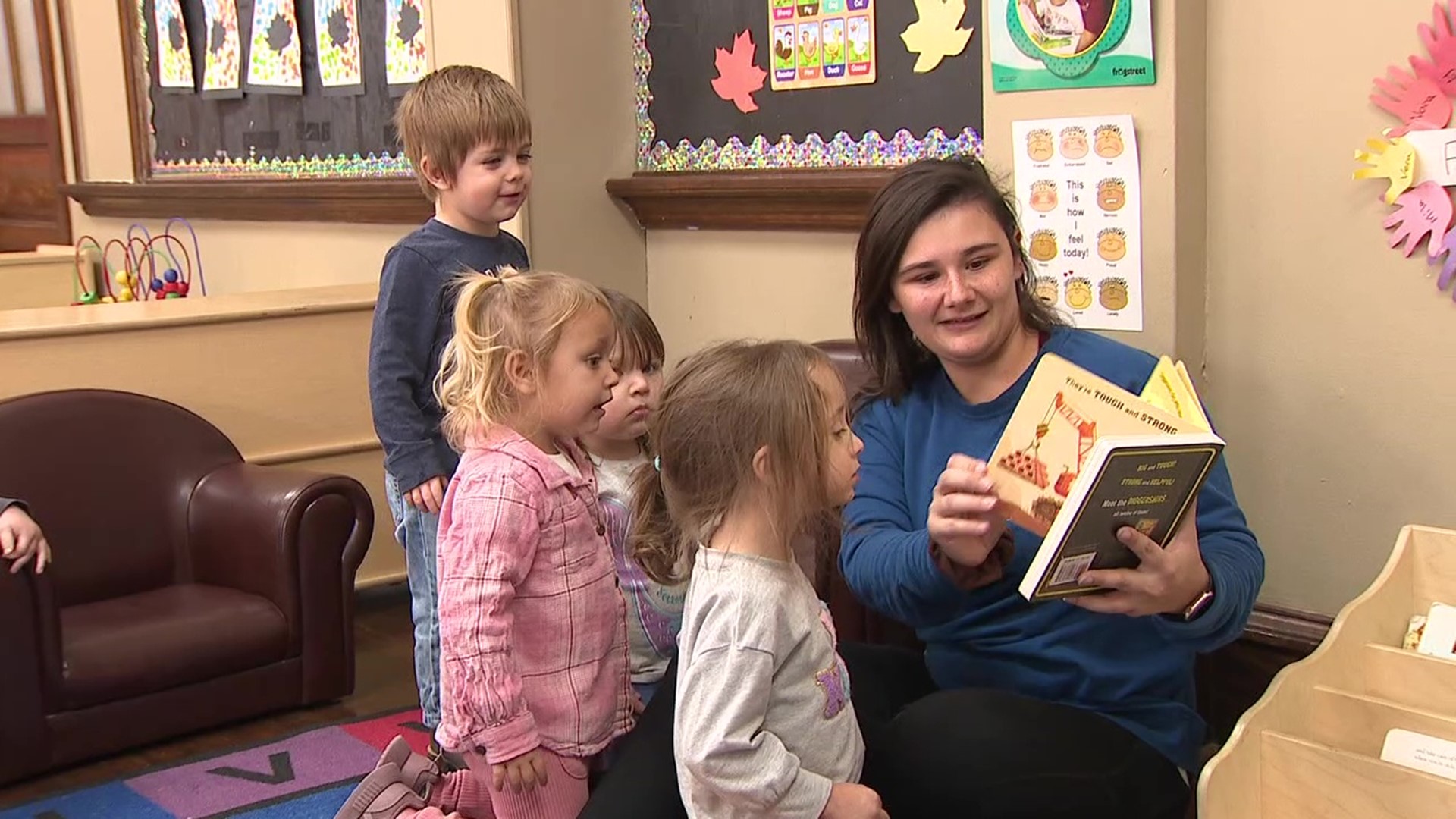LACKAWANNA COUNTY, Pa. — Happy hearts, gentle hands, listening ears, and kind words—that's the motto of the Martin home in Throop.
Hannah Martin is a stay-at-home mother of two. She spends her days with her sons, Lewis and Ramsey.
Before the boys were born, Martin managed a personal fitness studio and worked as a nurse, but high day care prices forced her to stay home with the boys.
"When you add up what you pay someone versus what you're making, it's like, is it even worth it? Is it even worth it to go back to work?"
In the house next door, it's a similar struggle for Raquel Cruz, a mother of three. Her youngest child, August, is in day care full-time. For her, day care is about socialization, but the cost is a concern.
"Right now, it's basically a second mortgage," Cruz said. "It's just around the same price."
It costs her $200 per week, which, according to the U.S. Department of Labor, is less than the average price per month at an infant-based center in Lackawanna County.
Throughout northeastern and central Pennsylvania, Lackawanna County has the most expensive child care prices, with parents paying an average of $12,000 per child every year.
That's why Cruz has had to put her passion for art on hold to take care of her children. She hustles daily to make extra money.
"I do Instacart deliveries. I do Uber Eats deliveries. I help my parents with their business sometimes. I face paint. I try to do commission work for painting," Cruz said.
It's not only hard for parents; it's also difficult for child care centers like Tri-Star Academy in Jermyn.
"Child care is in a crisis nationwide," Kathleen Pearage said. "It is not just northeastern Pennsylvania."
As the owner of this facility and three others, Pearage made it through the COVID-19 shutdown, reopening her centers, and the struggles brought on after the pandemic.
Federal emergency COVID-relief funds provided $39 billion to support child care centers and parents—some of which Tri-Star received at the beginning of the pandemic. However, those benefits expired in September.
Gov. Josh Shapiro's administration says the Department of Human Services also invested significant funds during the pandemic to address child care workforce shortages and provider stability.
Regardless of the help, Pearage says it hasn't been enough.
"It was a Band-Aid," Pearage said. "The further we got away from COVID, the more the need for child care increased. So, we pushed that issue down the road so that it was exasperated at the worst time, when our wait lists were getting longer, when the staff said, 'I'm not coming back."'
Pearage is still dealing with staffing issues. She currently has about 12 teacher openings across her centers.
"They get to that realization, and they find out, 'I can go work at McDonald's, Sheetz, wherever.' They can go work somewhere else and make a lot more money doing it. That's what they're doing."
Pearage can only afford to pay her staff around $11 to $16 an hour, depending on the role. That falls in between the national average a child care worker makes at $13.22 an hour, according to the Department of Labor.
In April, Pearage hosted a roundtable with other child care centers and lawmakers to bring attention to the problem.
Months later, she says nothing has been done to help ease the burden on centers and families.
"We're losing out on quality staff because we can't pay them what they're worth. We can't pay them what they're worth because the money comes from parents, and those families are already tapped out."
Another mother, Alexis McGhee, knows what it's like to be tapped out. She received some help from the state's Child Care Works Program, which helps low-income working families pay their child care fees.
But it didn't last long. Once she got a job and made more than the threshold allowed, she didn't qualify anymore.
Struggling with wait list after wait list, she opened up Little Sprouts Academy herself near Jermyn.
"I'm dancing a very fine line of productive business in the green and also paying people a living wage and helping parents anywhere I can," McGhee said.
But it isn't easy. To get subsidized child care services in the state, a family of four must make less than $60,000 yearly to qualify.
Earlier this year, the Shapiro administration increased base rates for child care providers participating in the Child Care Works Program. But for those working, middle-class families who don't qualify, it doesn't matter.
These parents say more needs to be done.
"I think the cost of living just does not match up at all with the expenses of everything for everyday life, and I also think it's super important that child care be tackled first because it allows families to work, and that helps with a lot of economic issues," Cruz said.
"It's time people start putting children first. That's where the issue lies," Pearage added. "Everyone agrees, yeah, there's a problem, let's fix it. But when it comes time to walk the walk, that doesn't happen."
Many other countries offer all parents some type of subsidized child care for young children, but the United States does not.
In Pennsylvania, no solution is currently in the works to further help families and child care centers.

